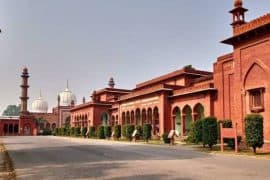The University of Delhi, with its highly subsidized education and with a plethora of Gender Cells and Enabling Units may look like the ideal place to be but its education pattern and infrastructural facilities are structured in a way that largely benefits able bodied, upper-middle class, privately schooled, English speaking students.
The internet and its spawn twitter have made everyone with an internet access, a potential activist. And with this sense of activism on the internet I came to know about the concept of inclusivity- which is a concept that asks whether an institution, organization or work space is accessible, suitable and does justice to people from all ethnic backgrounds, socio-economic backgrounds, and gender identities and does not condone ableism. In 2015, Brown University allocated $100 million dollars to make it more inclusive. This shows how globally renowned colleges are doing a reality check of their own hidden biases and it is time DU did the same. Inclusivity in a university space is important because first, invisible barriers in education means putting disadvantaged communities at a greater disadvantage by keeping them away from education and second, students who will learn in a non-inclusive, privilege rewarding environment will tomorrow propagate that kind of behaviour in their respective work spaces, simply because their idea of society in general would be warped and distant from reality, they were never sensitized about their hidden privilege while learning.
Here’s why DU is not all that inclusive and how this affects certain students and communities particularly-
1) Lack of hostels– as of now there are only 15 colleges that have hostels available for undergraduate students in DU. Eight of them are girls hostels, with one of them for foreign students, two boys hostels and only four colleges that have both girls and boys hostels. These hostels can accommodate on an average no more than one-fifty students. When a college student body consists of some four-thousand students, this number appears to be pitiably-low. Since DU attracts students from all over India and in large numbers, it falls upon the shoulders of these students to find appropriate accommodation for themselves. They resort to living in private hostels which cost some Rs. 12,000 on an average. Thus, studying in DU for those not from Delhi/those who don’t get a college hostel is expensive. Ergo, DU is, speaking in general terms, a feasible option only for those who can afford private accommodation. The accommodation issue is one which also makes us question the subsidized nature of DU’s education and make its status as a diverse and accessible university dubious.
2) Lack of uniformity in facilities available for differently abled students and academia– the biggest problem for differently abled students is that there are vast discrepancies in facilities offered to differently abled students. While a handful of top-ranking colleges have ramps, elevators, tactile paths and active enabling unit cells, the remaining don’t. These six or seven colleges act as tokens that make DU appear more democratic and inclusive but in most colleges, differently-abled students continue to suffer because of broken tactile paths, ramps with no railing, no elevators, broken recording machines and limited or no braille libraries.
3) Linguistic barriers- the medium of communication for most classes in DU is English. Majority of students, who hail from a Hindi-medium educational background, find this problematic. They rely on guide books and the help of friendly classmates to tide through lessons. And while professors try to be accommodating, if they held their classes in Hindi alone, students who don’t speak the language would be at a heavy disadvantage. Nanditha Harimohan of Daulat Ram College says” Since I do not speak Hindi, if all my classes were conducted in Hindi I would quickly lose interest and end up assuming things”. This linguistic barrier affects all those who are not fluent in either English or Hindi. Unless the university acknowledges this issue as a legitimate problem, an adequate solution to it will never come by and it will continue to be a conundrum that plagues students.
4) High cut-offs – While each one of us works exceptionally hard for our boards’ percentage, it is important to keep in mind that it is much easier for a student hailing from an urban private school to score 95% in their boards than it is for someone studying from a government school in a far-off village. And while both study diligently, one has an invisible privilege over the others. There is no shame in being privileged but it is essential to acknowledge it. While top universities across the globe take a subjective approach towards determining ones achievement and dedication, this system in our University, which reduces everyone’s individual struggles to a number, to a game where a 0.25 less means heartbreak and crushed dreams is strangely dehumanising. Scoring marks in boards is an objective, soulless process where wealthier students with their ten-year question papers, private tuitions, goals oriented not knowledge oriented studying and guidance on how to study and write answers; will always do better.
5) Good infrastructural facilities offered only in a handful of colleges – The idea of what DU is and what it stands for, for a lot of people across the country is limited to St. Stephens, Lady Shri Ram College for Women, Shri Ram College of Commerce and Hindu College. Ceilings have fallen in Daulat Ram College, Hans Raj College and College of Vocational Studies (twice). While certain off-campus colleges or lesser known colleges are crumbling away, authorities remain unconcerned. Basic issues like lack of adequate number of washrooms or a shortage of classrooms is seen in many colleges but these issues remain un-highlighted because leaders and administrators only bother visiting the top six or seven colleges. Narendra Modi visited SRCC, Smriti Irani visited Hindu College but colleges where no major infrastructural improvements have taken place in decades are side-lined and few renowned people in the public eye seem interested in visiting those. A highly subsidized education cannot obviously offer the same kind of amenities that a privately funded education might, but in institutions where basic needs remain unfulfilled, it is impossible for any academic or cultural breakthroughs to take place. These colleges are not neglected for a lack of funds. Out of the Rs.300 crores that has been given to DU by the UGC from 2012 to 2017, only Rs.100 crores was spent and of the remaining amount Rs.105 crores lapsed. So while colleges continue to hike their fees or suffer due to a cash crunch, grant money remains unutilized. If the administration bothered to look at the almost pitiable state of certain colleges, this could have been avoided. This inherent sense of elitism where politicians, actors and famous personalities visit a handful of colleges and remain bothered with only them is discriminatory and not inclusive because it limits the resources the rest of the student body has access to.
A College of Vocational Studies student has the same right to sit in a classroom, where ceilings do not fall on their head as a St. Stephens student does. Elevators for wheelchair bound students are needed in every college, not just the five most renowned ones. Everyone deserves the opportunity to study in the University of Delhi, not just those who can choose to spend two-lakh rupees annually as PG rent due to lack of hostels. A student hailing from a small village in Eastern Uttar Pradesh and studying in a government school worked hard for her 85% in boards and deserves the same chance to study in DU as another 95% hailing from an ISC affiliated private school’s student. It is important that both the student body and administration work actively in order to make DU a make inclusive space. Our responsibility towards making the world more inclusive is not limited to sharing dramatic tumblr posts about lack of people in the Trump cabinet. While that is certainly important but our responsibility also extends to and includes our immediate surroundings, our colleges, our workspaces, our films and pop-culture and our environment.
Image Credits: Equal Opportunities Cell, University of Delhi website
Kinjal Pandey
[email protected]





Comments are closed.